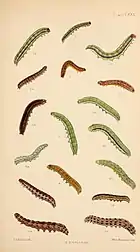Xestia alpicola
Xestia alpicola, the northern dart, is a moth of the family Noctuidae. It is found from northern Europe across the Palearctic to central Siberia and in the Alps.
| Northern dart | |
|---|---|
 | |
| Scientific classification | |
| Kingdom: | Animalia |
| Phylum: | Arthropoda |
| Class: | Insecta |
| Order: | Lepidoptera |
| Superfamily: | Noctuoidea |
| Family: | Noctuidae |
| Genus: | Xestia |
| Species: | X. alpicola |
| Binomial name | |
| Xestia alpicola | |
| Synonyms | |
|
Agrotis alpina Humphreys & Westwood, 1843 | |
Technical description and variation
The wingspan is 35–40 mm. Forewing grey shaded with fuscous, with only a slight reddish tint in the middle, the stigmata, which are large, and the lines, fairly distinct; hindwing fuscous with pale fringe; the female smaller than the male; — ab. hyperborea Zett. has the grey ground more varied with reddish and fuscous, the markings clearer; — in ab. aquilonaris Zett., grey clouded with brownish fuscous, the markings are blurred; all these greyer forms are from Lapland; — ab. alpina Humphr. & Westw., is buff grey varied with red, occurring in the North of Scotland and Ireland; — ab. coerulescens Tutt is the rich red-brown form with lilac-grey markings and blackish wedge-shaped streaks, found in the Shetland isles; — ab. carnica Hering is the rufous insect taken in the Carinthian Alps.[1]

Biology
Adults are on wing from June to August. It has a two-year life cycle, the larvae overwintering twice.
Larva brown-red; dorsum with dark striae forming a row of V-shaped marks; dorsal and subdorsal lines ochreous, partially black-edged; spiracular pale and obscure. The larvae mainly feed on Empetrum nigrum, but have also been recorded from other plants, including Calluna

Subspecies
- Xestia alpicola alpicola (Zetterstedt, 1839) (northern Europe to central Siberia)
- Xestia alpicola alpina (northern British Isles)
- Xestia alpicola carnica (Hering, 1846) (Alps)
- Xestia alpicola ryffelensis (Oberthür, 1904) (Alps)
References
- Seitz, A. Ed., 1914 Die Großschmetterlinge der Erde, Verlag Alfred Kernen, Stuttgart Band 3: Abt. 1, Die Großschmetterlinge des palaearktischen Faunengebietes, Die palaearktischen eulenartigen Nachtfalter, 1914